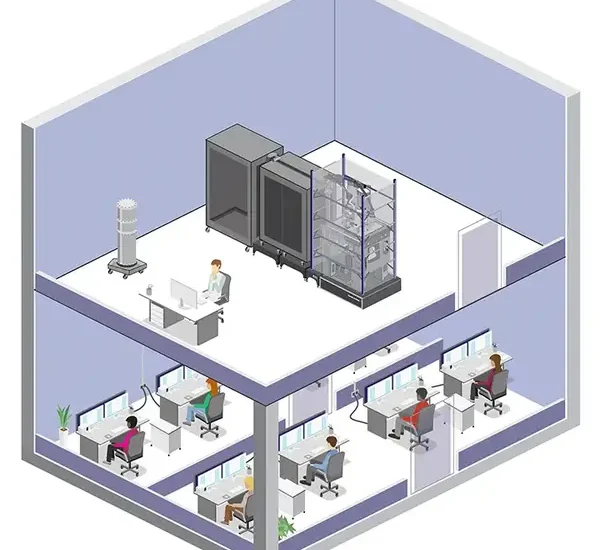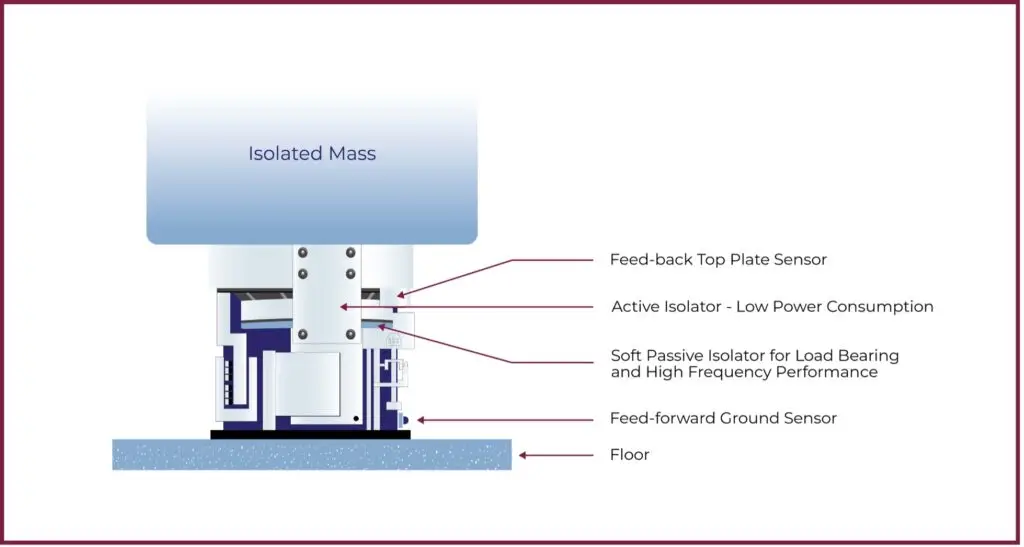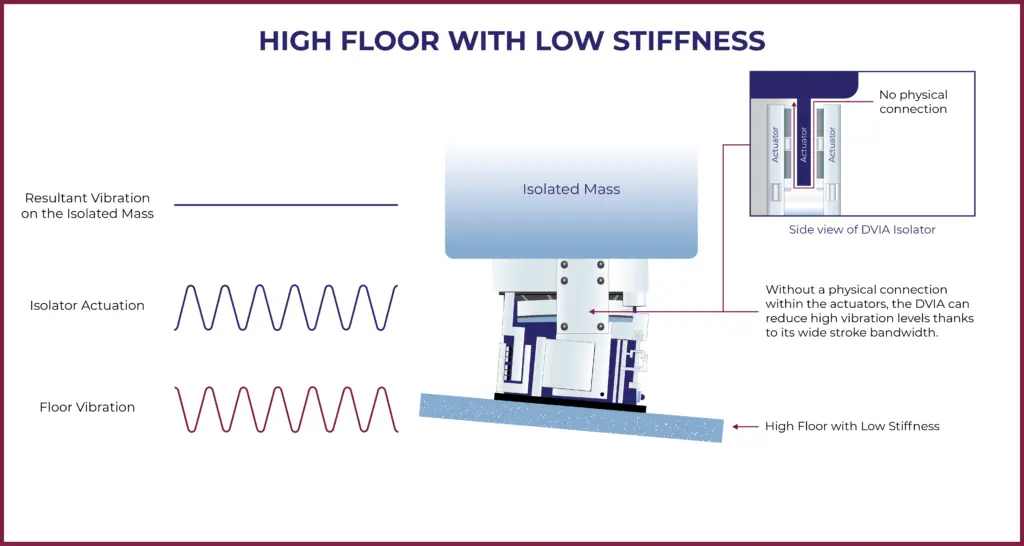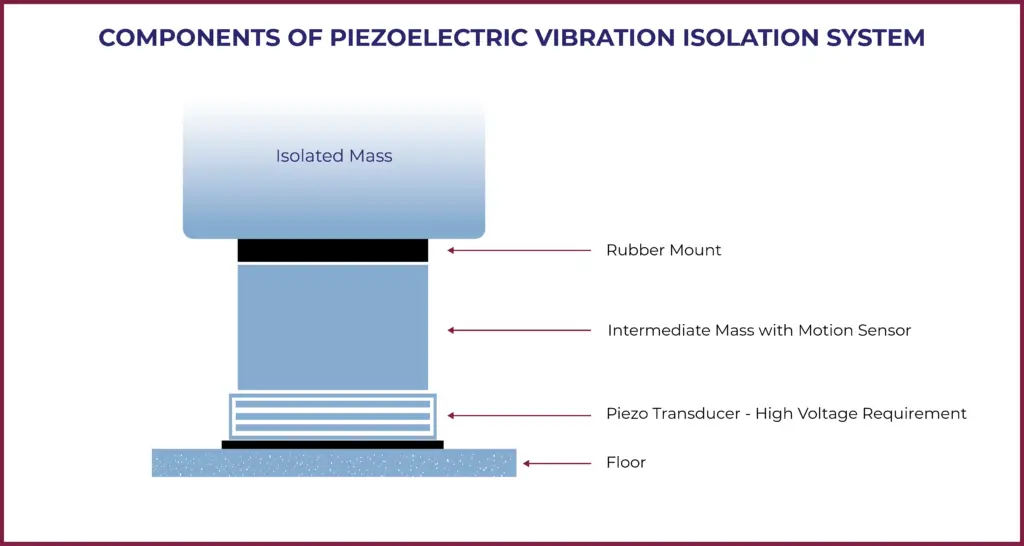
Electron Microscopes on High Floors: Why VEC’s Daeil DVIA Systems Are the Only Vibration Isolation Option
Electron Microscopes and precision instruments often have strict vibration requirements to perform optimally. To meet these strict requirements, instrument owners usually install these instruments on a slab on the ground floors due to the lower vibration levels. Furthermore, these owners sometimes cut their existing floors to install “isolated slabs” with the hope of improving ground floor vibration further. However, these requirements limit the number of potential locations suitable for precision instruments and, therefore, the number of instruments available for research and production. These limitations restrict the user’s research and production capacity or require acquiring additional real estate to support growing requirements.
Although many customers have floor space available on higher floors, other vendors, particularly vendors with piezo-based isolators, communicate strict floor stiffness standards or require drastic measures to find intersecting support structures, making higher floors a virtual non-starter. Enter the Daeil DVIA Active Isolation System that overcomes these hurdles using advanced controls and an intelligent design.
How the Daeil DVIA System Works
Daeil Systems engineers the DVIA Active Isolation System to address these vibration challenges effectively. Here are the components of the system and why it achieves superior performance:

Daeil System Components
- Passive Isolator bears the load of the instrument
- All active vibration isolation systems have a passive component, and the DVIA-M series uses pneumatic isolators, while the DVIA-U series uses spring isolators. These isolators both support the load of the instrument and enable the actuators to cancel low-frequency vibration with less power consumption.
- Eleven vibration sensors to detect ground vibration and measure ground vibration on the Isolated Mass:
- Top Sensors (8) – measure all six degrees of freedom, including pitch, roll, and yaw on the Isolated Mass.
- Bottom sensors (3) measure XYZ ground vibrations.
- Electromagnetic actuators actively cancel low-frequency vibration
- Linear magnetic actuators cancel out vibration on the isolated mass in six degrees of freedom. The selection of electromagnetic actuators eliminates physical contact between isolated and non-isolated masses, allowing for enhanced vibration control and dramatically reducing the requirement for floor stiffness.
- Feedback and Feedforward Control Systems are the brains of the DVIA system
- The feedback control loop measures the vibration on the isolated mass and sends a signal to the actuators that cancels the vibration.
- The feedforward control loop measures the ground vibration and proactively cancels it before it reaches the isolated mass. This loop provides the DVIA with exceptional low-frequency vibration isolation performance.
- Both the feedback and feedforward control loops are dynamic and immediately adapt to intermittent vibration sources and other environmental changes.
Why the Daeil DVIA System excels in situations with lower floor stiffness – such as high floors in buildings
The primary reason the DVIA active vibration isolation system excels at mitigating vibration on floors that are not very stiff is the selection of electromagnetic actuators and the feedforward control loop.

There is no physical connection between the ground and the isolated mass in the actuator.
Because the DVIA actuators use electromagnetics to cancel out vibration, there is no physical contact between the ground and the isolated mass within the actuator itself. As a result, the part of the actuator on the isolated mass cancels the vibration while floating free of physical connection to the part of the actuator connected to the ground. As a result, the actuator does not require a stiff surface to push against to eliminate low-frequency vibration effectively.
The isolator's passive component bears the instrument's load, so the DVIA actuator requires limited power consumption.
With the instrument’s load on pneumatic isolators for the DVIA-M and springs for the DVIA-U, the electromagnetic actuators require less power (<110W) to cancel the vibration detected on the ground. As a result, the DVIA can make nuanced inputs to the instrument using the feedback and feedforward control loop, enabling the DVIA system to perform exceptionally, even in conditions with low levels of floor stiffness.
Feedforward control capitalizes on the benefits of system design.
Since there is no physical connection within the actuator itself between the ground and the isolated mass, and the isolator passive component bears the load of the instrument, the feedforward loop can instantaneously detect high levels of vibration on the floor and send low levels of current to the actuator to cancel it. As a result, the isolated mass floats in perpetual low vibration even while large impulses and other sources cause significant floor deflection.
The Limits of Piezoelectric Platforms

While piezoelectric (PZT) vibration isolation platforms are commonly seen in the market, they face significant limitations regarding floor stiffness. Here’s why:
Physical connection within the isolator between the ground and the isolated mass
A piezoelectric actuator works by converting electrical energy into mechanical displacement through the piezoelectric effect. A material like lead zirconate titanate expands or contracts when an electric field is applied, allowing for small movements by changing the voltage. This means that by applying a voltage, the material physically changes shape, which is used to cancel vibration.
Limited Stroke Capability
Piezoelectric actuators have a short range of motion (stroke length), and this limitation becomes problematic on flexible or low-stiffness floors, where larger vibration amplitudes are common.
Inherent Stiffness
Although the isolated mass sits on top of a rubber pad above the isolator, the physical connection in the piezoelectric actuator itself adds stiffness, limiting flexibility. As a result, piezoelectric actuators are unsuitable for environments where floor stiffness is inadequate, such as higher floors.

Increased Lead Time and Burdensome Site Installation Requirements
To perform optimally, the piezoelectric system often requires epoxies to mount the isolators to the ground to achieve the necessary stiffness for the isolator to work effectively. These requirements add installation complexities and have timeline implications that don’t exist with a DVIA isolation system provided by VEC.
Don’t limit your options with a Piezoelectric system
The Daeil DVIA systems outperform the piezoelectric platforms by addressing these limitations head-on. Unlike the piezoelectric platforms, the DVIA system:
- Is Effective on Low-Stiffness Floors. The DVIA systems perform exceptionally well on flexible or low-stiffness floors, including higher building levels.
- Handles Complex Vibrations. The DVIA system can mitigate high-level vibrations caused by structural dynamics or impulse vibrations from lab activities or movement in adjacent spaces.
- Provides Flexible Installation Options. The DVIA system enables the installation of high-precision instruments on any floor, removing the need for ground-floor-only setups.
Conclusion
The DVIA Active Isolation System empowers researchers and professionals to use sensitive instruments in environments with significant vibration challenges. By eliminating the limitations of stiff connections and adapting to low-stiffness floors, the system ensures optimal performance for high-precision work—whether on the ground floor or the 10th floor.
Contact us to get started on your project. The VEC Team is ready to help find the best solutions for your investment.














